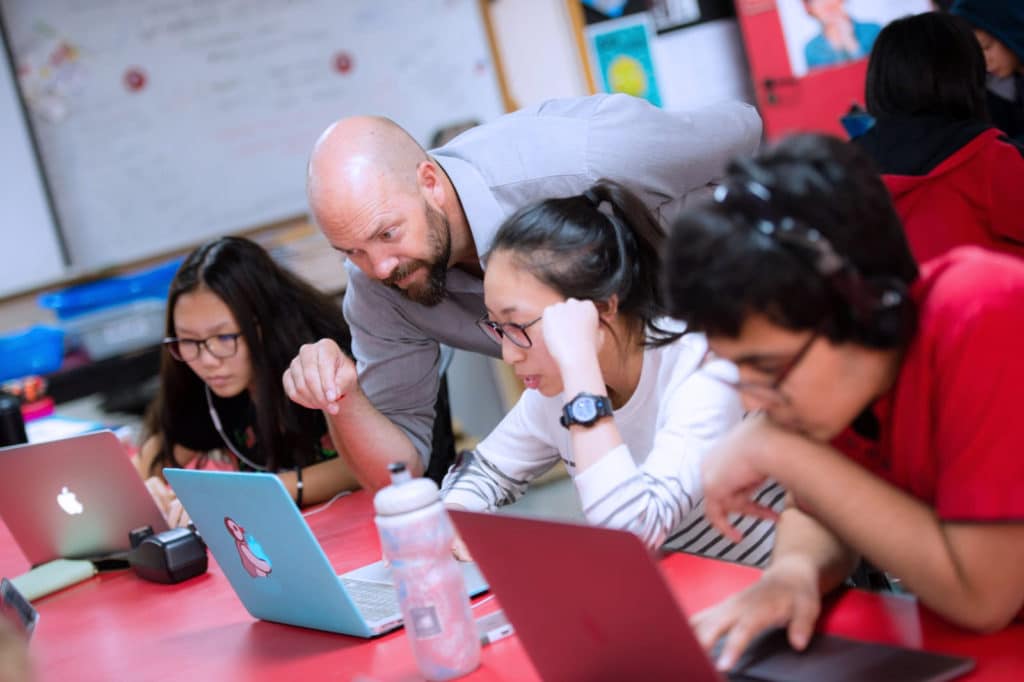In J.K. Rowling’s Harry Potter and the Prisoner of Azkaban, Hermione Granger is given a special necklace called a Time Turner that enables her to take three courses in one class period. Taking three courses concurrently in one lesson block is an impressive accomplishment and really shows a lot about Hermione as a character.
But the Wizarding World she studies within is fictional. This begs the question, “what happens in the real world when a Muggle has to teach three courses in one class period?” Blended learning online is one answer.
Enter Daniel Budd. He’s the Robotics & Computer Science Specialist at Hong Kong International School. Hong Kong International School is an American curriculum school on the south side of Hong Kong Island that’s been operating since the 1960s. Daniel was brought on board to develop and implement a robust computer science curriculum at the school.
Keeping computer science ahead of the curve
The Covid-19 pandemic impacted teachers and instructors around the world. This impact was often negative. But Daniel was prepared since his classes always involve guiding students as they interact with technology.
Claned was an easy choice because it’s a “flexible, lightweight, and powerful tool.” Daniel uses it to teach concurrent classes, which help him accommodate his students’ needs. Without combining courses, they wouldn’t run because of enrolment quotas. So he teaches up to three classes in one lesson block.

This would be an impressive accomplishment for any teacher. Claned helps Daniel interact with his students in more meaningful ways, person-to-person, while teaching these three courses concurrently with Claned.
Even more impressive: he teaches these concurrent courses in three different programming languages at the same time: JavaScript, Python, and Swift, which is the computer science equivalent of teaching a Spanish class, a French class, and a German class to native English-speaking students concurrently.
Blended instruction meets student needs
A blended model allows Daniel to prerecord instructions and interact one-on-one with all students taking any of the courses. He also takes care to adjust courses to students’ needs. His courses are taught to visual arts standards, which the students like, and the numbers prove it: this creative approach to interface development caused 200% more students to choose technology classes, with 20% more girls enrolling.
Claned helped Daniel shift his computer science classes toward creativity, and the course discussions followed. This creates a culture where girls eagerly participate in class discussion, too.

Without Claned, Daniel wouldn’t be able to teach students in different contexts and languages. The flipped, or blended, approach lets him individualise learning pathways. Claned is fundamental to helping him track students individually and make sure they are supported or challenged as they need to be on individual levels.
And Claned’s delineated analytics help him visualise the information he needs to have important conversations with students. As for the students, they are developing real world skills like Agile product management methodologies and how to track project progress using Kanban.
Meaningful, person-to-person interactions
Daniel’s students present their work on Mondays, which helps them benchmark their own success relative to their classmates.’ However they can always check their own progress bar in Claned too.
This helps them track and manage their work. Other features that make his lessons all the more valuable to his students are how Claned lets them annotate and comment within the course content. Students can pause a course’s video to comment as part of a classroom-wide discussion happening in realtime within Claned.
This collaboration within Claned helps students stay engaged even while working individually in the online learning environment.

Claned’s analytics help Daniel evaluate what content is working and what isn’t. The balance between the challenge versus competence in assessments helps guide him in understanding how well the students are learning.
This in depth look at the students’ progress helps guide his process to improve the course for future students too.
A technological learning environment
Daniels listed some tools that help his students better engage with his course content. These include the built-in Padlet integration as well as Trello boards, Microsoft Teams, Google, and Zoom. This approach allows students to interface even from a distance.
But according to Daniel, Claned isn’t just a repository for these tools. Rather, “it’s the glue that holds everything together.”
Claned is the best-in-class tool to help students complete their tasks and use course content to prepare for successful futures. It’s the online aspect in particular that Daniel feels is helping his students engage in the technical world that exists today. “School doesn’t reflect industry, but it’s a necessity that needs to prepare students for their working lives.”

Covid has been a great catalyst for students to learn fundamental skills for how to manage their time online. They’re learning to work effectively, and respond to each other in discussions as they study online. This is a timely skill, since how to work collaboratively online is something plenty of adults have struggled with during the pandemic.
Empowered students take ownership
Claned’s environment and content delivery lets the learners can really engage in their own projects. This can make projects feel more personal than a traditionally contact-taught class and improve engagement.
It lets students think less about upcoming assessments and instead focus on the quality of their work. And it helps teachers impart actionable skills and use individualised assessments to improve their future classes.

An experienced teacher, Daniel loved how Claned incorporated top-rate research on course design into the digital course environment. With Claned, you don’t just sign up for a piece of software and have access to it. The training for course admins is invaluable instructor onboarding.
It was robust and guided Daniel, which he appreciated as teacher knowing how to structure content. Claned helps learners can really digest the course material and understand what they learn… and apply it in real world applications with online tools. Claned’s instructional design affirmed his knowledge in pedagogy and how that can be applied in an online course.
Daniel’s four top tips for teachers new to Claned:
- Rethink assessments. Students need to be able use skills they’re learning in real world situations.
- Chunk videos into manageable pieces, so students can easily reference what they need to review.
- Create units (boards) rather than complete courses. This way, it’s easy to remain dynamic and move course content to meet student needs.
- Use the AI built into Claned. It’s helpful to make sure course is delivering the outcome it needs to. It also suggests content that fills gaps in the course and helps students succeed by keeping them engaged.
Daniel’s success story was truly inspirational! We want to help your elearning courses better serve learners around the world, and we’re ready to deliver the world-class educational experience your students deserve! Book a demo today to get started on your journey to best-in-class online learning pathways!







